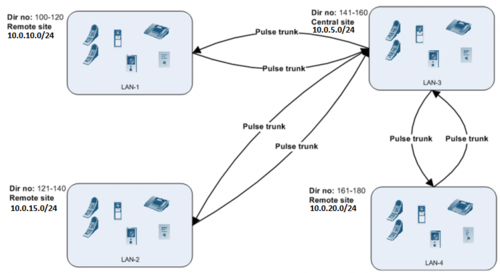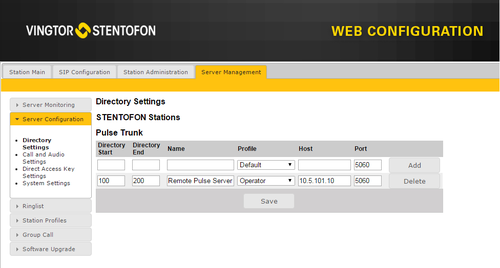Pulse Trunking: Difference between revisions
From Zenitel Wiki
| Line 18: | Line 18: | ||
==Configuration== | ==Configuration== | ||
Pulse Trunk Routes must be configured to enable calls between different Pulse sites. A route consists of: | |||
# Number range for the site the route goes to | |||
# Logical name for the route | |||
# IP address and SIP port of the remote Pulse Server on the remote site (Pulse Server SIP port is normally 5060) | |||
# Profile to assign calls coming from/to the route. Profiles can be used to restrict access to/from a route | |||
For two sites to call each other 2 routes must be configured. First a route must be configured in Pulse Server 1, the route must define the number range of Pulse site 2 and the ipaddress of Pulse Server 2. In addition Pulse Server 2 must have a configured route to Pulse site 1, with the number of range Pulse site 2 and ipaddress of Pulse Server 1. | |||
A client may only call to sites where there exists direct routes. In the example with Central site the Remote sites may only call Central site, because they only have only configured a route to Central site. The Central site may call all of the Remote sites because it has configured routes to each Remote site. | |||
Revision as of 10:02, 16 June 2017
Pulse Trunking makes it possible to call between different Pulse systems. The routing between Pulse systems are easily configured in the Pulse Server Directory.
Prerequisites
- The Pulse Server must be a station in the Turbine family with software version 4.2.3.9 or higher. Note that Pulse Trunking is not supported when INCA Station is used as Pulse Server.
When using a Pulse server with ver. 4.7:
- A Pulse Enterprise License (Item no. 1009660002)
When using a Pulse server with ver. 4.2:
- A Pulse Enterprise License (Item no. 1009660002)
- A Pulse Trunking License (Item no. 1009662101) per route.
Features
- Easy to configure and setup
- Supports supplementary functions such as call transfer, call forwarding, ringlist and station profiles
Configuration
Pulse Trunk Routes must be configured to enable calls between different Pulse sites. A route consists of:
- Number range for the site the route goes to
- Logical name for the route
- IP address and SIP port of the remote Pulse Server on the remote site (Pulse Server SIP port is normally 5060)
- Profile to assign calls coming from/to the route. Profiles can be used to restrict access to/from a route
For two sites to call each other 2 routes must be configured. First a route must be configured in Pulse Server 1, the route must define the number range of Pulse site 2 and the ipaddress of Pulse Server 2. In addition Pulse Server 2 must have a configured route to Pulse site 1, with the number of range Pulse site 2 and ipaddress of Pulse Server 1.
A client may only call to sites where there exists direct routes. In the example with Central site the Remote sites may only call Central site, because they only have only configured a route to Central site. The Central site may call all of the Remote sites because it has configured routes to each Remote site.
To add a route on a Pulse Server, go to
Server Management -> Server Configuration -> Directory Settings
- Directory Start:
Start of the number range on the remote Pulse system. - Directory End:
End of remote number range on remote Pulse system.
Note! The number range defined in a Pulse Trunk configuration must have the same amount of digits. For example 200 - 299, not 50 - 150.
- Name:
Logical name for the route. - Profile:
Profile to assign calls coming from/to the route. Profiles can be used to restrict access to/from a route. - Host:
IP-Address of remote Pulse system.. - Port:
The SIP port of remote Pulse system.
Example
| Name | Saturn |
| IP Address | 192.168.1.10 |
| Numberplan | 40-80 |
| Name | Venus |
| IP Address | 192.168.5.10 |
| Numberplan | 120-160 |
IMPORTANT INFO REGARDING MULTIPLE PULSE SYSTEMS ON ONE LAN IP SUBNET Because of the Pulse auto-detect and configuration, it is NOT recommended to run multiple Pulse Systems on the same LAN IP-Subnet. If you still, despite our recommendations want to run multiple Pulse system on the same lan subnet, we strongly recommend that you -Connect and set up Pulse system 1 -Disconnect Pulse system 1 -Connect and set up Pulse system 2 -When done with all separate configuration, connect both Pulse systems. If you are going to do configuration changes, please remember to disconnect the other Pulse system from the network.
Limitations
- Transit calls: A client may only call to sites where there exists direct routes. In the example in the top of this article, the satellite Pulse sites may only call to central site, while central site can call all sites. Call Transfer/Forwarding can only be done to stations to which there is a direct route.
- Group calls: It is not possible to do group calls from one Pulse system to another.



